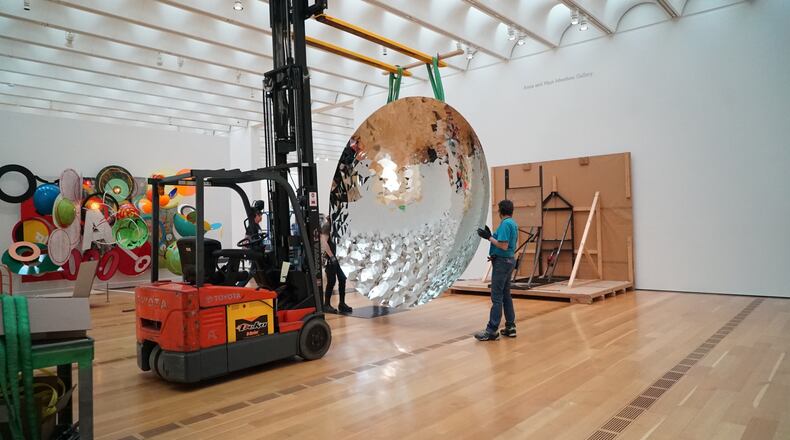Upstairs at the Wieland Pavilion in the High Museum of Art, amid the clatter of workers and the wreckage of plastic wrapping, beyond a litter of opened wooden cases, dollies and scaffolding, Kara Walker's sweeping, panoramic cut-paper mural commands its own kind of quiet.
Almost 60 feet wide and 13 feet tall, “The Jubilant Martyrs of Obsolescence and Ruin” is installed on a curved wall at one end of the Skyway Level. A visitor can walk within the arms of the curve and stand embedded in this disturbing anti-Cyclorama.
Walker’s work references the cut-paper silhouettes of a bygone era, and subverts that genteel style to portray Civil War-era scenes of murder, infanticide and other abominations. The High acquired the piece in June 2017, but it has been under wraps since then.
It's almost ready. On a recent Wednesday, only a few shreds of blue masking tape interrupted the stark black-and-white surface. The public will see it for the first time Sunday, Oct. 14, when the High opens the doors on the reinstallation of its permanent collection.
That reinstallation, the first since the museum doubled its size with the 2005 expansion, has given the High a chance to show off some of the 6,500 acquisitions since that year, including the Walker piece, and to rethink the system by which the collections are displayed.
Chief curator Kevin Tucker, who arrived at the High in 2017 just as the plans for the reinstallation were getting off the ground, said he asked the directors of each division to give him an elevator pitch. “I am new,” he told them. “Tell me your compelling story.”
Next came an effort to find a coherent organizing principle for the High’s collections, which are deep in folk and self-taught art, contemporary art, photography and the decorative arts.
The result looks at works that share inspiration, spirit, influence, and puts them together to spark conversation. African art might share space with self-taught artists from the American South, and self-taught artists will be placed up against contemporary artists to show the energy exchanged between the two.
Related: new exhibit by Glenn Kaino and Tommie Smith.
Among the changes:
• A new media gallery with bench seating in the Anne Cox Chambers Wing will screen films, videos, computer art and other digital images. The area is open to the rest of the museum, but a “light-lock” keeps the lighting in the gallery at an appropriately dim level.
• On the Wieland Pavilion Lower Level is a gallery dedicated to the High's extensive photography collection, which will offer five times as much space as previously committed to photographs. The first exhibit in the gallery will be an overview of the High's long history of supporting this art form, called "Look Again: 45 Years of Collecting Photography," and will include works by Edward Weston, Diane Arbus, William Eggleston, Nan Goldin and others.
• The adjacent Works on Paper gallery will highlight even more works from the High’s deep photography resources, showcasing more than 100 works from an Alabama native in an exhibit called “William Christenberry: Time and Texture.”
• The 60-foot-tall design by minimalist Sol LeWitt will return to the atrium of the Stent Family Wing.
• Several pieces by self-taught and folk artists, among the 54 works acquired last year from the Souls Grown Deep Collection, will be revealed for the first time, including "Crossing Waters" by the late Thornton Dial.
Tucker, who is 6-foot-4 and broad at the shoulders, looks more like a football player than an aesthete as he walks among the workers and the wooden crates. (The son of a PGA pro, he actually played golf in high school.)
But even he looks diminutive against the backdrop of the Kara Walker mural. “You can stand here,” he said, stepping into the embrace of the curved wall, “and you can feel like you’re inside the work.”
EVENT PREVIEW
The High Museum will introduce the museum's reinstallation Saturday, Oct. 13, at an exclusive $1,000-a-ticket gala, with dinner and dancing. The public is invited to see the reinstallation Sunday, Oct. 14. Since it is a "second Sunday," admission is free from noon to 5 p.m. The High Museum is open 10 a.m.-5 p.m. Tuesdays-Thursdays and Saturdays; 10 a.m.-9 p.m. Fridays; noon-5 p.m. Sundays. $14.50, ages 6 and older; free for children 5 and younger and members. High Museum of Art, 1280 Peachtree St. NE, Atlanta. 404-733-4444, high.org.
About the Author
Keep Reading
The Latest
Featured






